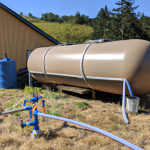Collecting Rainwater for Self-Reliance: Prepare for the Unexpected
The importance of being prepared for unexpected events cannot be overstated. Whether it’s a natural disaster, an economic downturn, or simply a disruption in the water supply, having a backup plan in place can make all the difference. One essential aspect of self-reliance is the ability to collect and store rainwater for household use. In this article, we will explore the benefits of rainwater collection and provide a step-by-step guide on setting up your own system.
Why Rainwater Collection?
Water scarcity is a growing concern worldwide, and it is not limited to arid regions. Even areas with abundant rainfall can experience water shortages due to inadequate infrastructure or contamination. By collecting rainwater, you can ensure a reliable supply of clean water for various household needs, including drinking, cooking, cleaning, and irrigation. Additionally, rainwater collection helps to reduce strain on local water sources and mitigates the impact of droughts.
Step 1: Assess Your Needs
Before setting up a rainwater collection system, it’s crucial to assess your water requirements. Consider the number of people in your household, daily water consumption, and specific needs such as gardening or livestock. This evaluation will help you determine the size of the system and the storage capacity required.
Step 2: Determine Collection Area
Identify the most suitable area for collecting rainwater on your property. This can be a roof, patio, or any other surface that rainwater can easily drain into. Ensure that the area is free from contaminants like chemical treatments or debris that could contaminate the collected water.
Step 3: Install Gutters and Downspouts
To effectively channel rainwater to your collection area, install gutters and downspouts along the eaves of your roof or the designated collection area. Make sure the gutters are properly sloped to allow water to flow freely towards the downspouts. Use downspout filters to prevent debris from entering the collection system.
Step 4: Choose a Collection System
There are various types of rainwater collection systems available, including above-ground tanks, underground cisterns, and rain barrels. Select a system that suits your needs and budget. Consider factors such as durability, capacity, and ease of maintenance when making your decision.
Step 5: Install First-Flush Diverter and Filters
To ensure the collected rainwater remains clean and free from contaminants, install a first-flush diverter at the beginning of your collection system. This device diverts the initial flow of water, which may contain debris and pollutants, away from the storage tanks. Additionally, use filters to remove any remaining sediment or particles from the collected water.
Step 6: Set up Storage Tanks
Install your chosen storage tanks in a secure location, preferably on an elevated platform to allow gravity-fed distribution. Ensure the tanks are tightly sealed to prevent mosquito breeding and contamination. Consider using opaque tanks to inhibit algae growth and preserve water quality.
Step 7: Connect to Your Household Plumbing System
Connect your storage tanks to your household plumbing system to make the collected rainwater easily accessible for your various needs. Include a backflow preventer to ensure contaminated water cannot flow back into the municipal supply.
Step 8: Maintain and Monitor
Regularly maintain and monitor your rainwater collection system to ensure optimal functioning. Clean filters, check for leaks, and periodically test the water quality. Make any necessary repairs or adjustments promptly to guarantee a continuous supply of clean water.
Be Prepared and Self-Reliant
By taking the proactive step of setting up a rainwater collection system, you are enhancing your self-reliance and preparedness for any unforeseen events. Remember, water is a precious resource, and ensuring its availability in times of need is not only prudent but also essential for the well-being of you and your family. Start your rainwater collection journey today and empower yourself to face the future with confidence.



GIPHY App Key not set. Please check settings